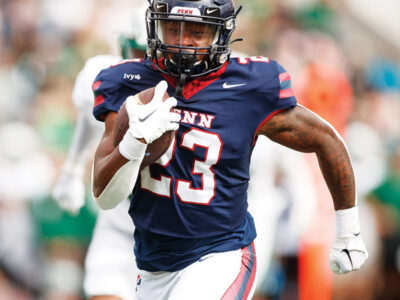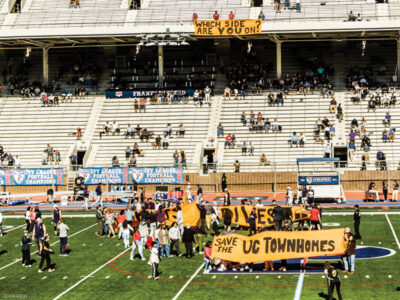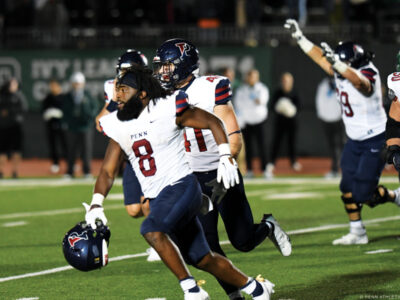By David Porter | The first two months of Penn’s 2006 football season featured the emergence of several players in key roles, the re-emergence of another player in a leading role, another installment in what has become the Philadelphia area’s most riveting football rivalry (apologies to Eagles and Cowboys fans), and a milestone for the man who has been the program’s heart and soul for the last decade and a half. It added up to three wins in four games as a competitive Ivy League race awaited.
No doubt there are few members of the Quakers who are happier to be on the field this season than junior running back Joe Sandberg, who was one of several players to suffer a shoulder injury last season. His occurred against Villanova early in the season, which meant he played most of that fall with the wounded joint, not realizing the severity of the injury. He still managed to gain 399 yards on 76 carries while splitting time with Sam Mathews C’06.
“It was something that I thought would just get better,” Sandberg said. “But it didn’t, and then I went to get an MRI and it didn’t come back the way I wanted.”
Arthroscopic surgery and four-and-a-half months of rehabilitation followed—“long and tedious” is how Sandberg describes it—that forced him to miss spring practice. Any questions about his game worthiness were answered in the season opener against Lafayette: He scored four minutes into the game on a 1-yard run and finished with a career-high 166 yards on 24 carries in Penn’s 21-11 victory. Through four games he had already surpassed his 2005 rushing total and had scored four touchdowns, just two fewer than he scored all of last year.
Sandberg’s return to peak form came at just the right time for Penn’s offense, which began this season with first-year offensive coordinator Shawn Halloran and untested sophomore quarterback Robert Irvin at the controls. Head coach Al Bagnoli played it safe and scaled back some of the Quakers’ offensive schemes to give both time to adjust.
“When you have a young quarterback, you have to be careful because so much of the offense goes through him,” Bagnoli said. “So we started things off simply, and we’ve expanded as we feel he’s gotten a confidence level. The tough part was, there’s nothing he can’t do. We go down the list and say, ‘Can we go vertical with him? Yes. Can we throw a comeback [pattern]? Yes.’ So pretty soon you’ve got 50 plays you can run, but we don’t have time to practice all of them.”
At an imposing six feet, five inches and 210 pounds, Irvin—a native of Austin, Texas, who attended high school in Davidson, North Carolina—has physical gifts in abundance; as he has gotten more comfortable with Penn’s offense, he has begun to bring them to bear on opposing defenses. In his first collegiate start against Lafayette, he was 17-for-27 for 182 yards, with one touchdown rushing; in a 34-24 win at Bucknell on October 7, he was 23-of-33 for 304 yards, with two touchdowns through the air. The patient approach appears to have paid off.
“It’s a hard offense to learn,” Bagnoli said. “It all depends on who the trigger guy is. He didn’t get a snap last year, which was probably a mistake on our part. With the coaching changes, we tried to start off a little easier with him and some of the young receivers, and now they feel a little more comfortable than they were in week one.”
Before the season Bagnoli had been optimistic that at least one player out of a group of wide receivers would emerge to complement seniors Matt Carre at wide out and Chris Mizell at tight end. That player has turned out to be junior Braden Lepisto, a California native whose father and brother both played at UCLA. Through four games, Lepisto was second on the team with 18 catches, one behind Carre. Against Bucknell he caught seven passes for 140 yards, the most yardage in a game for a Penn receiver since Dan Castles W’05 gained 145 yards against Dartmouth in 2004.
The one blemish on Penn’s record was an excruciating loss to Villanova that seems to have become an annual rite for the Quakers. For the second year in a row, the game ended with Penn in possession inside the Wildcats’ 10-yard line but unable to score. The wild contest featured five scoring plays of 25 yards or more, including junior Greg Ambrogi’s 60-yard punt return and a 74-yard touchdown run by Sandberg. Nevertheless, the 27-20 loss left Bagnoli 0-5 in his career against Villanova, with the last three losses by an average margin of a touchdown.
“ I don’t know what I’m doing wrong,” he said with a rueful chuckle. “It was just one of those games. There is no margin for error against them. It wasn’t that the kids weren’t prepared or that the effort wasn’t there. They played their tails off. Villanova’s just a tough team.”
Villanova is also the rare exception on Penn’s schedule, a team that Bagnoli has not been able to solve. The victory at Lafayette represented his 100th win with the Quakers, placing him alongside George Woodruff—who compiled a record 124 wins as coach from 1892 to 1901—as the only two of Penn’s 21 football coaches to reach the century mark.
The overall mood around the team is vastly better than it was in the final weeks of 2005, when a dispirited group limped home to end the season with consecutive losses to Brown, Princeton, Harvard, and Cornell. With those four on the horizon again—not to mention surprising Columbia, which had won three of its first four games at presstime—there is a measure of confidence that was largely absent a year ago.
“Coming to camp, a lot of guys were hungry to get things on the right track,” Sandberg said. “Losing four games in a row was uncharacteristic of this team. Now everyone’s got a positive attitude.”
David Porter C’82 writes for the Associated Press.




